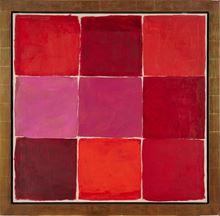About
RAYMOND PARKER was born in 1922 in Beresford, South Dakota. He studied painting at the University of Iowa and received his Master of Fine Arts degree in 1948. Parker began his professional career as an art instructor at the University of Minnesota and in 1955 began his tenure at Hunter College in New York, where he remained until his retirement. Parker’s distinctive style emerged in 1958 when he exhibited a group of outsized works that measured six feet square with surfaces filled with large color shapes floated against neutral backgrounds. Color dominates Parker’s works, and it is used both as form and for expression, as in the work of fauve painters early in the century.
Throughout his career Parker used color as a point of departure, but as his style developed during the 1960s, his compositional forms became increasingly geometric. Parker did not use the clear geometries of cubism, but instead gave the massive colored shapes that dominate his compositions rough, unfinished outlines. The predominant style of Parker’s paintings of the 1960s is seemingly improvisational in his layering and clustering of forms in varied tones, relationships, and sizes. During the 1970s, Parker introduced lines into his canvases, intermixing linear elements with irregular shapes to create simple, dramatic, highly colored compositions, such as his large painting, Untitled (1979) in The Phillips Collection. Over the course of his career, Parker’s works were shown in numerous solo and group exhibitions across the United States.
Ray Parker died in 1990 at age 66, in New York, New York.
Throughout his career Parker used color as a point of departure, but as his style developed during the 1960s, his compositional forms became increasingly geometric. Parker did not use the clear geometries of cubism, but instead gave the massive colored shapes that dominate his compositions rough, unfinished outlines. The predominant style of Parker’s paintings of the 1960s is seemingly improvisational in his layering and clustering of forms in varied tones, relationships, and sizes. During the 1970s, Parker introduced lines into his canvases, intermixing linear elements with irregular shapes to create simple, dramatic, highly colored compositions, such as his large painting, Untitled (1979) in The Phillips Collection. Over the course of his career, Parker’s works were shown in numerous solo and group exhibitions across the United States.
Ray Parker died in 1990 at age 66, in New York, New York.
Work Selection

Untitled